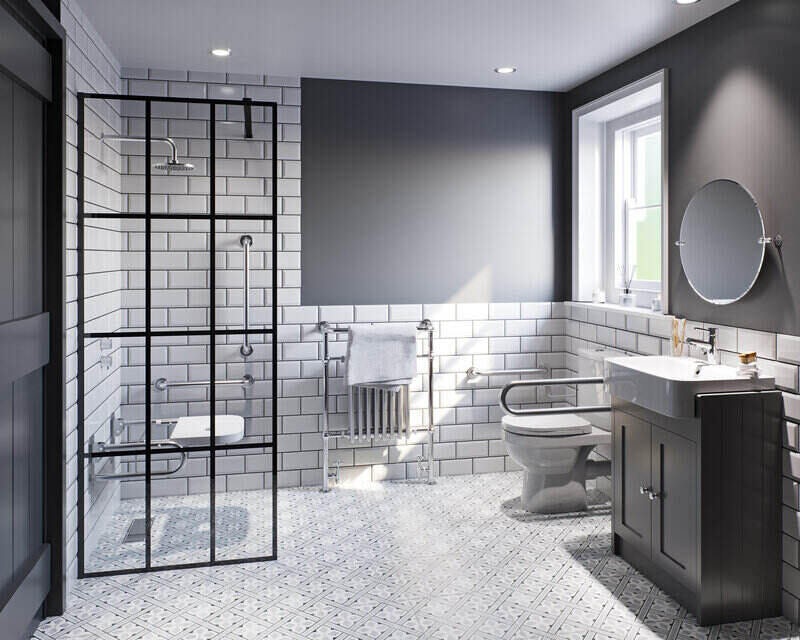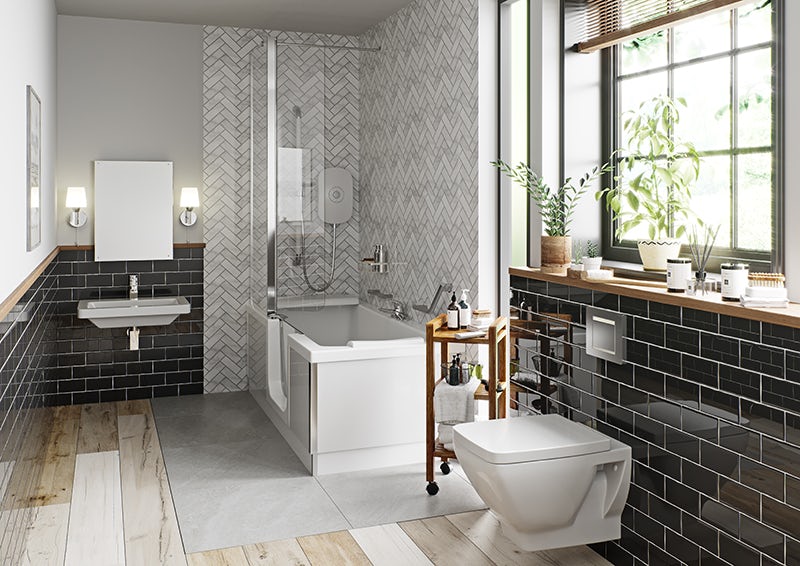Mobility bathrooms remain popular due to their simplicity and ease of use, so how much should you pay for one?
As we enter our more senior years, a bathroom that is both accessible and stylish becomes a more attractive proposition. With so many homeowners looking to make adaptations (e.g. fitting grab rails or installing a walk in shower) there is one question we’re often asked: How much is a mobility bathroom?
In this article, we'll take you through the ins and outs of a mobility bathroom, including why you should get one installed, types of products available and, to answer the question above, how much one costs. After reading this whole article, you should know whether a mobility bathroom is the right choice for you.
Modern mobility bathrooms needn’t be dull or sterile. With our Independent Living range, they can be both safe and stylish
What is a mobility bathroom?
In broad terms, a mobility bathroom is a washroom with special features designed to make it easier to use for people with disabilities or mobility issues. These special features are designed to cater to a wide variety of needs and can include things like grab rails, wheelchair-optimised toilets, walk-in showers, shower seats and emergency call alert buttons.
A good example of a mobility bathroom, with fold down grab rails for a wheelchair user
How much is a mobility bathroom?
The price of a mobility bathroom largely depends on the size and functionality of the features you choose. Prices for a walk in bath, for example, start at around £1,500 but can go upwards of £5,000 for a top-of-the-range model.
An assisted toilet, sink and handrail set can cost as little as £400, however, if you wish to explore more features and functionality, like those which come with an electronic bidet toilet, that price can go upwards of £2,000.
The price of a walk in shower unit—which includes a shower tray and glass screen—starts at £250, but a larger, more luxurious combination can cost over £1,000.
A showering pack for an assisted wet room, including handrails, a seat, a shower unit, curtain rails and curtains, can start from as little as £1,800.
Installation costs of each of these mobility bathroom features will vary depending on the size of your bathroom and the location of your home.
Installation costs also depend on the features of your existing bathroom. For example, it is relatively straightforward to replace a bath with a walk in shower in the same location. However, it may be more expensive to replace a shower with a walk in shower, as you may have to install a drainage system below floor level.
So, we’ve taken a quick look at individual features, but how much is a mobility bathroom? Well, it depends on the features you want included. Head to our article How much should you pay to have your bathroom fitted for the latest installation costs.
Reasons to invest in a mobility bathroom
Given that a mobility bathroom can be a little more expensive than simply buying a standard bath or shower suite, you might be asking whether it's worth the investment. Mobility bathrooms aren't for everyone, but here are 5 reasons why it's worth considering installing one:
1. Easier to use
If you have mobility issues, using a standard bathroom can be a challenge. On the other hand, a mobility bathroom has been adjusted to suit your mobility needs, making it easier and more comfortable to use.
2. Regain your independence
Some people with disabilities require assistance from another person to go to the bathroom. With a mobility bathroom, in many cases, you'll be able to regain your dignity and independence by being able to use the bathroom without assistance. Indeed, it’s the very reason our mobility bathroom range is called “Independent Living”.
3. Improved safety
If you have mobility issues, navigating a standard bathroom can be tricky, and you may not be able to get up without assistance if you fall. A mobility bathroom has specially-designed features that improve safety so that if anything does go wrong, you'll be much better placed to deal with it. Finding out more about anti-slip tiles is always a good starting point.
4. Easier to clean
Mobility bathrooms are usually designed to be easier to clean than standard bathrooms, so just as you've regained independence to use the bathroom with confidence, you'll be able to clean it unassisted too.
5. Fully customisable
People can live with a wide spectrum of disabilities and mobility issues. Thankfully, mobility bathrooms are much more customisable than standard bathrooms. This makes it easier to find a solution that works for you.
Types of mobility bathroom products
There are several different options available if you're considering installing a mobility bathroom. These include:
Walk in baths
Walk-in baths are available if you have difficulty climbing into a standard bath. These baths have a door fitted in them, allowing you to walk into the tub without raising your legs. Once you're inside, secure the door shut and you'll be able to fill the bath to the correct temperature while you're inside it.
Walk in showers
Walk in showers are designed to make it easier to get into and use the shower. Unlike standard showers, these showers are level-access—meaning no step, so wheelchair users can access them with ease. If you have difficulty standing, you can also have a seat installed in the shower to allow you to shower while sitting down.
Wet rooms
If you want maximum flexibility in your mobility bathroom, a wet room may be the best option. Wet rooms allow you to use the whole bathroom floor space as a shower. That way, if you use a wheelchair, you can avoid having to manoeuvre it in and move into a tight space to shower, as is the case in a conventional shower area.
Assisted toilets
Assisted toilets (also known as “raised height” toilets) are usually designed to be a little higher than normal, making it easier for people with mobility issues to sit down. They are frequently combined with safety grab rails (often hinged) to make it easier when moving in and out of the toilet area. Lower or raised sink units often accompany assisted toilets to make hand-washing a more comfortable experience.
Do I have space for a mobility bathroom?
To make them easier to use, mobility bathrooms should ideally be a little larger than an average-sized bathroom. However, that doesn't mean it's impossible to create a mobility bathroom in a space that’s smaller than average. A shower room or wet room option is a popular choice for those with limited space or insufficient space for a walk in bath.
How long does it take to fill a walk in bath?
Once you've worked out that a walk-in bath needs to be empty before you can enter it, a common question about mobility bathrooms is: “How long do I have to wait?”
Typically, it takes 5–10 minutes to fill a mid-size bath, but this time can vary considerably depending on several factors.
- First, it depends on the exact size of your bath and how full you want it to be
- Second, it depends on the water pressure in your home
- Third, it depends on how you heat your water. For example, if you use a combi boiler, you may be able to fill the bath more quickly. However, if you use a storage heater, it may take longer if the tank isn’t large enough to fill a bath.
Find out more about mobility bathrooms
By now, you should have a good idea whether a mobility bathroom is right for you. However, if you’re still in need of further advice, why not browse our Independent Living articles? Depending on your needs, why not check out the following guides:
- How to create a stylish bathroom for an elderly relative
- How to create a stylish bathroom for a partially sighted person
- How to create a stylish bathroom for a wheelchair user
If you’re simply looking for some quick fixes, rather than a full renovation, why not take a look at our quick fixes for wheelchair accessible bathrooms, 5 ways to make your bathroom accessible yet stylish and further styling tips for accessible bathrooms.
We explain the differences between independent living and assisted living, as well as providing a handy guide to grab rails.
If you’re concerned your mobility bathroom may not look as stylish as you’d like, we’re here to show you otherwise! We demonstrate how to “Get the Look” with our Stylish Independence bathroom, and discover the very latest in style ideas for accessible bathrooms.
Shop Independent Living
Maintaining our independence is something we all value. At Victoria Plum, you’ll find a wide selection of high quality products for mobility bathrooms, as part of our Independent Living range. From taps that are easy to turn to raised height toilets, all our products are designed to make your bathroom more accessible and easy to use, conforming to all relevant safety standards. Why not browse the range today by clicking on the image below.












